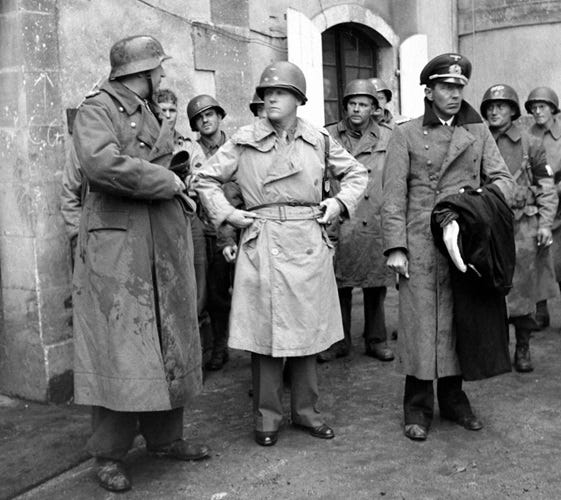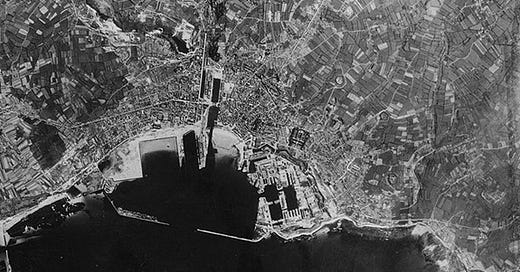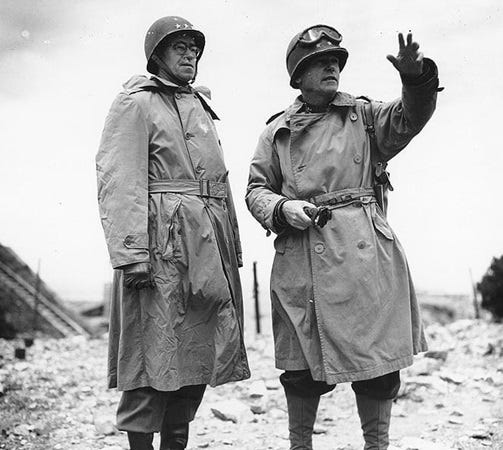After the consolidation of the D-Day bridgehead, the immediate objective of US First Army on the Allied right flank was the capture of Cherbourg. The possession of this large deep-water port, situated at the northern extremity of the Cotentin Peninsula, was considered essential to the success of the invasion, enabling supplies and reinforcements to be shipped to Normandy direct from the US and Britain, with no need to transfer them from cargo ships to landing craft for delivery over the beaches.
On D-Day therefore, the US 82nd and 101st Airborne divisions were dropped at the base of the Cotentin Peninsula with the twofold objective of securing the western flank of the Allied bridgehead and seizing the southeast approaches to Cherbourg. Despite the disorganization and confusion attendant on a night drop, the American paratroopers accomplished their mission, driving the German defenders north and west. The key engagement was at Carentan, a small coastal city at the northeastern base of the Cotentin. As long as the Germans held Carentan, the American beaches, Utah and Omaha, could not be linked up, and a drive north toward Cherbourg would not be possible.
By 10 June, the 101st Airborne Division had consolidated its units and was given the mission of capturing Carentan. The city was defended by two battalions of the 6th Parachute Regiment (2nd Parachute Corps), reinforced with surviving elements of other units. The battle raged from 10 to 14 June with heavy casualties on both sides. The American paratroopers captured the city on 12 June. The next day, however, 17th SS Panzer Grenadier Division, coming in from the south, launched a major counterattack to recapture Carentan.
The arrival of the 17th SS had been delayed by Allied air attacks, and Ultra, the top- secret Allied code-breaking operation, had provided Lieutenant General Omar Bradley, commanding US First Army, with early warning of the impending German counterattack. He therefore dispatched Combat Command A (CCA) of the 2nd Armored Division (XIX Corps), which had landed on Omaha Beach on 9 June, to the aid of the 101st.
The 17th SS counterattack struck the American paratroopers hard and was on the verge of retaking Carentan when CCA arrived. In an engagement that came to be nicknamed the Battle of Bloody Gulch, the US tanks and armored infantry stopped the Germans and drove them back with heavy casualties. With that, the Utah/Omaha linkup was secured, and the Cotentin Peninsula was effectively isolated. Meanwhile, as of 12 June VII Corps, initially with 4th Infantry Division and 90th Infantry Division under command, had pushed north from Utah Beach to within thirty miles of Cherbourg. VII Corps’ other three divisions soon arrived and a drive west across the peninsula commenced.
German forces in the northern portion of the Cotentin Peninsula consisted of a hodgepodge of divisions and battle groups, many of which had already suffered heavy losses. Field Marshal Erwin Rommel, commanding Army Group B, wanted to pull them back behind the fortifications of Cherbourg, where he judged that they’d be able to hold out for a long time. But as usual, Hitler would countenance no withdrawal; every foot of ground must be defended. When the Führer was finally induced to change his mind, he still insisted that a line be held outside the city itself—a characteristic splitting of the difference that consigned the defenders to early destruction or surrender. The only remaining question was whether the Americans could take Cherbourg before the Germans destroyed the city’s port facilities.
The capture of Cherbourg was the responsibility of Major General J. Lawton Collins, commander of the VII Corps. His nickname, “Lightning Joe,” was a testament to his hard-charging approach to command. Collins was one of the very few senior American commanders who served in battle against both the Japanese and the Germans. When appointed to the command of VII Corps at the age of forty-seven, he became the youngest corps commander in the US Army.
Collins drove his men hard, and he was unforgiving of the shortcomings and mistakes of his subordinate commanders, several of whom he summarily relieved when in his judgement they failed to measure up. But he got results. On 18 June, the 9th Infantry Division reached the west coast of the Cotentin, cutting the peninsula in two. As the remaining defenders withdrew toward Cherbourg in confusion, VII Corps commenced a three-division drive on the city.
The surviving German forces were under the command of LXXXIV Corps. Its commander since 12 June, General of Artillery Wilhelm Fahrmbacher, was relieved by Rommel on 17 June, the Army Group B commander suspecting that Fahrmbacher was attempting to circumvent Hitler’s stand-fast order. His replacement was Lieutenant-General Dietrich von Choltitz, who later gained notoriety as the last German military governor of occupied Paris. By this time, however, LXXXIV Corps had no effective control over the troops in the Cherbourg fortifications. The command of “Fortress Cherbourg” thus devolved on Lieutenant-General Karl-Wilhelm von Schlieben, the commander of the 709th Infantry Division, whose remnants formed part of the city’s 21,000-man garrison.
Schlieben was under no illusions that his tired and dispirited men could hold out for long, but as US forces closed in on Cherbourg, he refused Collins’ surrender demand, hoping to buy enough time for the city’s port facilities to be wrecked.
VII Corps commenced a general assault on the Cherbourg fortifications on 22 June, and on 25 June a joint task force of the US Navy and the Royal Navy (three battleships, two heavy cruisers, two light cruisers, eleven destroyers) opened a bombardment of the city’s seaward defenses. The Germans put up a stubborn fight at first, but when the 79th Infantry Division overran a key position, Fort du Roule, on 26 June, resistance collapsed. Schlieben was captured along with hundreds of his men, and by 1 July the last of the defenders had been mopped up.
Collins was said to be furious with Schlieben over the latter’s rejection of his surrender demand—no doubt because by the time that Cherbourg came into Allied hands, its port facilities had been thoroughly demolished. VII Corps thus scored something of a pyrrhic victory. By the time that the port of Cherbourg was made fully operational again, its importance in strategic terms was much reduced. The Battle of Normandy was over, and the Allied armies were far away, closing in on Germany’s western frontier. Nevertheless, the Germans had sustained a heavy defeat in the battle for the city.

Having consolidated a bridgehead and captured Cherbourg, the Allied command turned its attention to the problems of a breakout offensive. On the left flank, British Second Army was still stalled before Caen. On the right, US First Army now held a front in the bocage (hedgerow) country, where the terrain greatly favored the defenders. Field Marshal Montgomery, in overall command of the Allied ground forces, intended to fix the Germans’ armored reserves around Caen by mounting a threat to that vital sector, where a breakthrough would spell instant disaster for the enemy. Meanwhile, the Americans would advance through the bocage toward more open terrain from which a decisive breakout offensive could be launched.
But many weeks of frustration and acrimony were to pass before the Battle of Normandy reached the point of decision.







